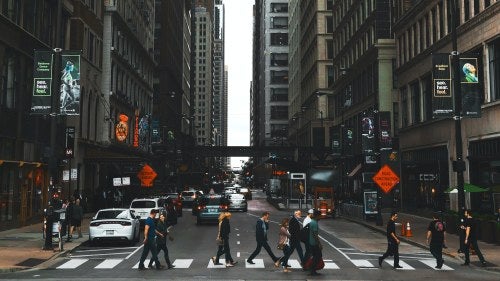The Pandemic-Driven Shift in the US Real Estate Market

The rise of remote work has had a dramatic impact on cities like Chicago, which must play to their strengths in order to compete in this new landscape.
As a Realtor in Chicago, and the immediate past chairman of the Global Real Estate Council for the Chicago Association of Realtors, I have witnessed first-hand the profound impact of the COVID-19 pandemic on the real estate markets both in Chicago and globally. The rise of remote work has greatly affected cities—from the changing value of residential homes to the reimagining of downtown areas, the potential long-term implications of these trends on the urban landscape in the United States may be far-reaching. Cities like Chicago need to respond to these changes and utilize their strengths to compete in this new landscape.
The pandemic ushered in a new era of remote work, with millions of employees working from home as a result. This shift disrupted the traditional draw of major city centers, leading to a renaissance for smaller cities and suburbs. For example, Austin, Texas, and Boise, Idaho, have experienced significant growth due to remote work opportunities and higher quality of living. The increase in demand in these areas led to higher home prices and median income. This is in stark contrast to larger cities like San Francisco and New York, which saw significant population declines.
The rise of remote work has also paid dividends for cities in warmer and more pleasant climates. Southern states such as Florida, Texas, and the Carolinas are the states experiencing the largest influx of residents. In my experience, buyers moving to warmer climes are usually motivated by the weather, along with employment opportunities and the chance to be closer to family.
With this shift in living patterns in the US, the importance of living in or near a city center for work has also decreased, with return to office levels hovering at about 50 percent nationwide—while global cities outside the US are returning to something closer to pre-pandemic work habits. In the Chicago area, I’ve worked with many buyers embracing the flexibility of remote work who are seeking more spacious and affordable living arrangements outside the city center.
Such a shift has contributed to an increase in the value of residential homes in suburban areas in certain metropolitan areas like Boston and New York, where people can escape the housing in the urban core which is typically more expensive, while suburban housing offer more land, space, and value. This trend is driving the construction of new housing developments in suburban areas, as developers capitalize on the increased demand for single-family homes, especially in the Sunbelt states. The resulting growth in suburban neighborhoods and smaller cities has the potential to reshape traditional commuter patterns and community dynamics. Fast-growing Sunbelt cities such as Nashville and Las Vegas are now experiencing increased congestion and gridlock as newcomers continue to arrive in cities with car-dependent, transit-weak transportation systems.
To remain attractive and competitive amid these changes, major cities are trying to build on their strengths, particularly by reimagining the purpose of their downtown areas. For instance, Chicago has plans to repurpose aging office buildings on LaSalle Street, traditionally the city’s financial center, into residential spaces. In fact, despite predictions of central-city decline, Chicago’s Loop neighborhood has seen an increase in residents by almost 10 percent since 2020, according to estimates from the Chicago Loop Alliance—likely encouraged initially by rents coming down in the central business district at the height of the pandemic, and now due to the attraction to the re-opened cultural attractions, transportation network and natural amenities like the nearby lakefront, whose pandemic restrictions have been lifted. This transformation may have long-term implications for the urban landscape, including a greater emphasis on residential developments and a decline in demand for traditional office space.
In addition to the repurposing of office buildings for residential use, some cities are exploring the prospect of converting commercial spaces into cultural and recreational venues. One example is in New York City, where film producers are using vacant office buildings as film sets. This shift could breathe new life into downtown areas, attracting new types of businesses.
The demand for housing and building types that accommodate work-from-home office space and modern-day living are likely to remain high even after the pandemic fades away. Cities can compete by building on their unique strengths, by promoting their cultural institutions, walkability and public transportation systems, natural amenities like lakefronts and parks. Tactics such as encouraging redevelopment of obsolete buildings can help them adapt to—and build—this new urban landscape. Ultimately, this shift can make cities stronger by pushing them to innovate and adapt to best meet the needs of its citizens in this new era.

